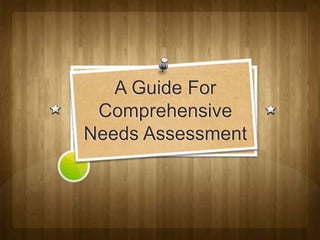
Comprehensive needs assessment
- 1. A Guide For Comprehensive Needs Assessment
- 2. What is Comprehensive Needs Assessment? •An attempt to assess the needs of individuals connected with education, by collecting data to document a challenge that exists. •To assess what is needed to close the gaps between the current status and the desired goal(s).
- 3. Requirements: Title I, Part A- programs for economically disadvantaged students -Must conduct annual comprehensive needs assessments to determine the children with the greatest needs. Title I, Part C- programs for migrant education -Must identify the needs of migratory children as part of their planning process. Title II- High quality teachers and principals. -Must determine knowledge and skills needed to ensure students meet standards. Title III- English Language learners and immigrant student populations -Must use a description of the need for their program Title V- programs for gifted/talented students, character education and innovative programs.
- 4. Why conduct a needs assessment? •Provides direction •Helps to determine priorities and allocate resources. •Helps align goals, strategies, professional development and outcomes. •Enables ability to benchmark and progress monitoring •Assist with continual growth plans to improve.
- 5. Dimensions of a Comprehensive Needs Assessment: Components: should be determined by local context •Consider needs •Gather information from a variety of sources •Uses valid and reliable data •Involves many individuals •Results in goals and action plan •Used to allocate resources •Has follow-up plan and strategies.
- 6. Focus: •Factors that have potential to impact student achievement •Should address: •Test score results , dropout rates, student mobility, attendance rates, graduation rates, curriculum and instruction Information gathering: •information gathered from a variety of sources Planning Teams: •A formal planning team is critical and should represent all types of people involved.
- 7. Use of results •Analysis of data is completed •Goals are identified •Action plans have emerged •Resources have been prioritized •Plan is in place •Monitoring is taking place
- 8. Planning for a Comprehensive Needs Assessment: 1. Create a committee 2. Determine who needs to be involved a. School district personnel b. Community representation 3. Prepare plan to manage assessment 4. Identify issues and concerns 5. Identify the measures
- 9. 6. Decide the priorities 7. Design the comprehensive needs assessment 8. Identify measures used
- 10. Gathering Data: Gather existing data: •Student demographics-language, socioeconomic status •Student achievement- assessment data collected •Curriculum information- standards aligned?, approaches and strategies •Professional Development- offerings, level •Technology- needs to be addressed •Family/Community participation (see page 11 in article for 6 types of involvement)
- 11. Analyzing data: •Prioritize needs- most important needs •Identify underlying causes- “6 whys” •Summarize findings-brief summary to use to generate plan Make decisions, Action Plan, Monitor •Focus decisions •Measurable goals and strategies to meet them •Take action and monitor progress